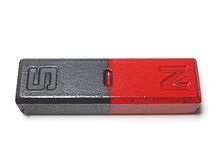Magnet

A magnet is a special kind of metal. When a magnet goes near a special kind of metal or another magnet, and the poles (sides) touching are opposite, it will pull, or attract the other object closer. If the two poles are the same, the magnet and the other object will push away, or repel, from each other. This attraction and repulsion is called magnetism.All magnets have north and south poles. Opposite poles are attracted to each other, while the same poles repel each other. When you rub a piece of iron along a magnet, the north-seeking poles of the atoms in the iron line up in the same direction. The force generated by the aligned atoms creates a magnetic field.
Types of magnet[change | change source]
Soft magnets (meaning impermanent magnets) are often used in electromagnets. These increase (often hundreds or thousands of times) the magnetic field of a wire that carries an electrical current and is wrapped around the magnet. The field also increases with the current. Magnetic Materials: Soft Magnets. Soft magnetic materials are those materials that are easily magnetised and demagnetised.
Permanent magnets have ferromagnetism. They occur naturally in some rocks, particularly lodestone, but are now commonly manufactured. A magnet's magnetism decreases when it is heated and increases when it is cooled. It has to be heated at around 1,000 degrees Celsius (1,830 °F). Like poles (S-pole and S-pole/N-pole and N-pole) will repel each other while unlike poles (N-pole and S-pole) will attract each other.
Magnets are only attracted to special metals. Iron, cobalt and nickel are magnetic. Metals that have iron in them attract magnets well. Steel is one. Metals like brass, copper, zinc and aluminum, silver are not attracted to magnets. Non-magnetic materials such as wood and glass are not attracted to magnets as they do not have magnetic materials in them.
Rare earth magnets[change | change source]
Lanthanoid elements can make very strong magnets. The spin of their electrons can be aligned, resulting in very strong magnetic fields. So these elements are used for high-strength magnets when their high price is not a concern. The most common types of rare-earth magnets are samarium–cobalt and neodymium–iron–boron (NIB) magnets.
Natural magnets[change | change source]
Natural/permanent magnets are not artificial. They are a kind of rock called lodestone or magnetite.
The compass[change | change source]
A compass uses the Earth's magnetic field, and points to the North magnetic pole. A north side of the magnet is attracted to the south side of another magnet. However, the north side of the compass points to the north pole, this can only mean that the "north pole" is really the magnetic south, and the "South magnetic pole" is really the magnetic north.
Discovery[change | change source]
Ancient people discovered magnetism from lodestones (or magnetite) which are naturally magnetized pieces of iron ore. Lodestones, suspended so they could turn, were the first magnetic compasses.
The earliest known surviving descriptions of magnets and their properties are from Anatolia, India, and China about 2500 years ago.[1][2][3] The properties of lodestones and their affinity for iron were written of by Pliny the Elder in his encyclopedia Naturalis Historia.[4]
Related pages[change | change source]
References[change | change source]
- ↑ Fowler, Michael (1997). "Historical beginnings of theories of electricity and magnetism". Archived from the original on 2008-03-15. Retrieved 2008-04-02.
- ↑ Vowles, Hugh P. (1932). "Early evolution of power engineering". Isis. 17 (2): 412–420 [419–20]. doi:10.1086/346662. S2CID 143949193.
- ↑ Li Shu-hua (1954). "Origine de la Boussole II. Aimant et Boussole". Isis. 45 (2): 175–196. doi:10.1086/348315. JSTOR 227361. S2CID 143585290.
- ↑ Pliny the Elder, The Natural History, BOOK XXXIV. The natural history of metals. CHAP. 42.—The metal called iron. Archived 2011-06-29 at the Wayback Machine. Perseus.tufts.edu. Retrieved on 2011-05-17.
